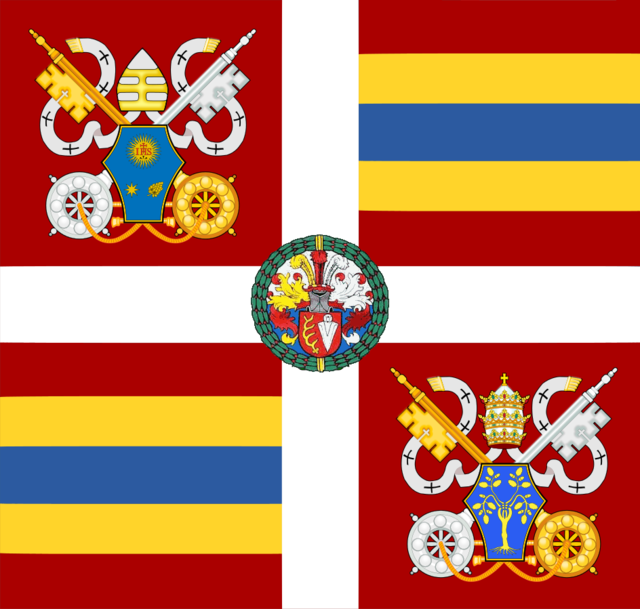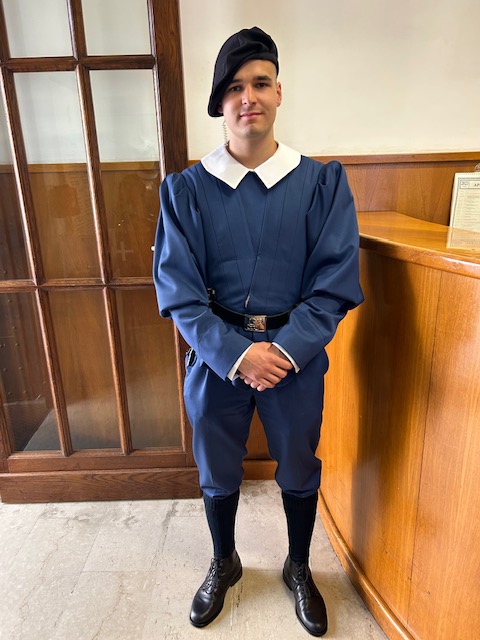For many years, every May 6th, some thirty recruits (only 23 this year) are sworn into the at most, 135-strong Swiss Guard in the St. Damasus Courtyard of Vatican City’s Apostolic Palaces. Founded by Pope Julius II in 1506, it’s the oldest and smallest military corps in existence.
During the hour-long ceremony, one-by-one, each recruit, grasping the Guard’s banner, and dressed in a red-yellow-and-blue striped dress uniform with bouffant slashed sleeves, an armor breastplate and red-plumed helmet, promises in his mother-tongue, French, German, Italian or Romanch, (Switzerland’s four official languages) to protect the pope’s life at the risk of his own: “may God and his saints assist me!” they declare.

Last week during a press invitation to this ceremony’s dress rehearsal I learned the Guard’s story, past and present:
Recruits must be Swiss citizens from birth, bachelors, between 19 and 30 years of age, at least five feet eleven inches tall, of good character, Catholic, have completed preliminary training in the Swiss army, and must sign a contract to serve a two-year tour of duty.
Before 1914 the Guard was only German-Swiss. Afterwards its recruits have enlisted from all parts of Switzerland, although the majority still comes from the German-speaking cantons of Unterwalden, Uri, Schwyz, and Lucerne especially. Serving in the Guard can be a family tradition. Twenty-four Pfyffer von Altishofens have served as officers; nine of them as “Kommandant” or Commander‑in‑Chief.
About two-thirds don’t re-enlist because of the low salary (1,500 euros a month), lack of privacy, monotonous guard duty, tough army discipline, long hours (two days of ten-hour shifts followed by a third day free). Plus, there’s always duty on Sundays.
Most join for the prestige or the opportunity to come to Rome, but their social life is strictly limited.

They must live in the barracks and aren’t allowed to invite women friends to visit. If they re-enlist, they can’t marry unless they’ve completed a third year of service, sign up for another three, and one of the eleven Vatican apartments assigned to the Guard vacates. In their “free time” the recruits, now halberdiers, must study Italian and technical and commercial courses to prepare them for their future civilian life.
Forty-five Guards are on duty at all times. Even before May 6th the recruits must learn how to handle their omnipresent halberd and how to sink gracefully on the right knee with it held perpendicularly in the right hand: the papal salute. Although they always carry their halberds while on duty, the Guards also wear a handgun and containers of a Mace-type spray, concealed in their uniforms. In addition, since the attempted assassination of Pope John Paul II in 1981, they attend target practice and karate and judo lessons with a black-belt master.
Their job includes guarding the State of Vatican City so they stand guard at its three main entrances: Gate to Nervi’s Audience Hall, the Bell Arch, St. Anne’s Gate, and outside Santa Marta, Pope Francis’s residence, 24 hours a day, and keep order at the pope’s public appearances: liturgical celebrations in St. Peter’s, General Audiences, and visits by ambassadors or heads of state. A number accompany the pope on pastoral visits abroad.
Contrary to what guides tell tourists, Michelangelo didn’t design their multi-colored dress uniform. Nor did Raphael. Worn for the first time in 1914, the apparel was designed by the Kommandant Jules Repond. Its bouffant sleeves, however, date to the mid-sixteenth century, and were possibly inspired by a Raphael painting.

The Guard narrowly escaped annihilation on the steps of St. Peter’s during the Sack of Rome when on May 6, 1527, a thousand German and Spanish soldiers stormed the Vatican. Three-quarters of the 189 Swiss complement, or 147 men including the commanding officer, were massacred. The surviving 42 Guards protected Pope Clement VII and 13 cardinals as they fled to safety along the Vatican ramparts to the impregnable Castel Sant’Angelo fortress.

After this 1527 slaughter, the Guards never again saw combat, but on occasion a pope has ordered them to lay down their arms.
One example is, when, during his invasion of Rome in 1809, Napoleon carried Pope Pius VII off to exile at Fontainebleau in France.
Another was during World War II when Pope Pius XII ordered them to patrol the frontier between the State of Vatican City and Italy with only their halberds. Nonetheless, Nazi Germany’s Panzer tanks never once dared to cross that border.
Another true story relates that during Clement XIII’s coronation in 1758, some Guards turned away a Franciscan friar who didn’t fit in with the cardinals and dignitaries. Eleven years later, after the same ex-friar had been crowned Pope Clement XIV, he supposedly said, “I enjoyed this coronation. This time the Swiss Guards let me in!”












